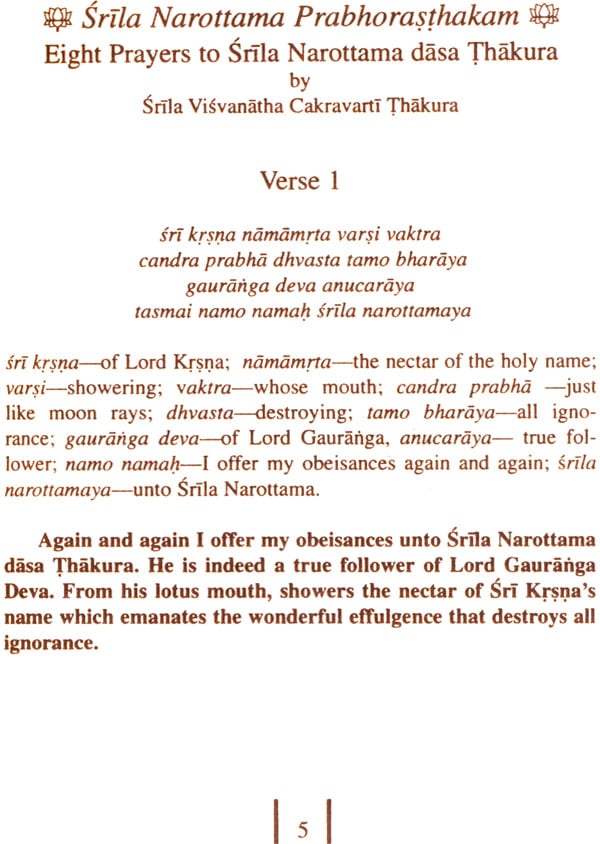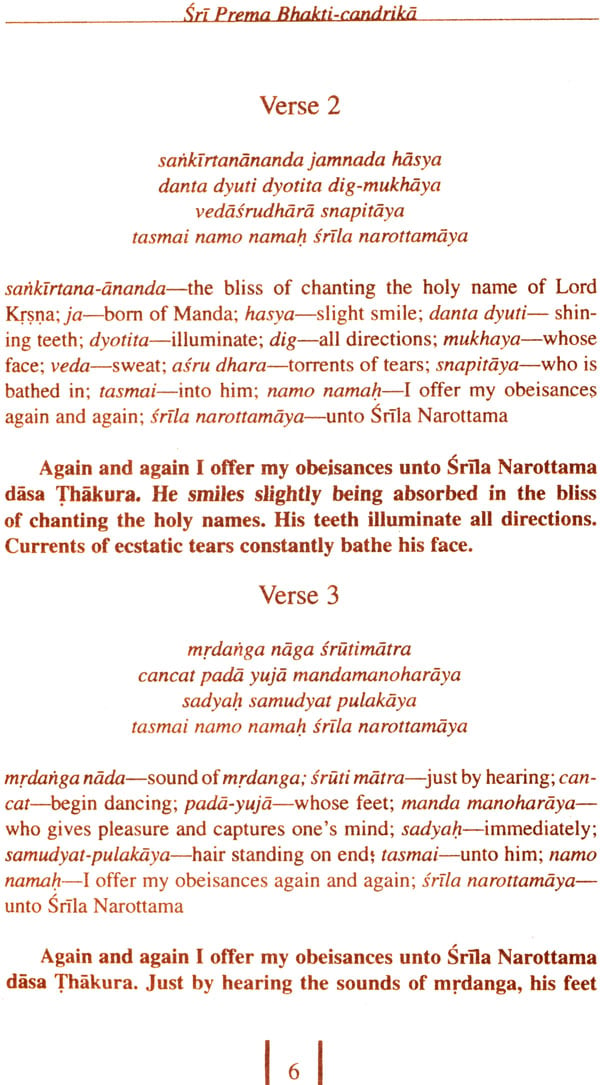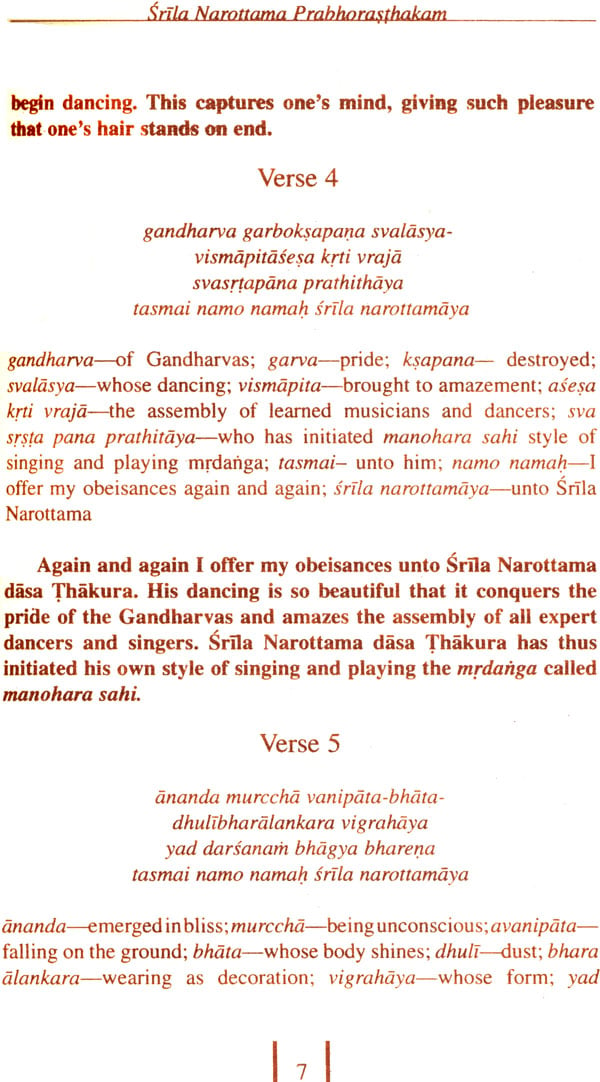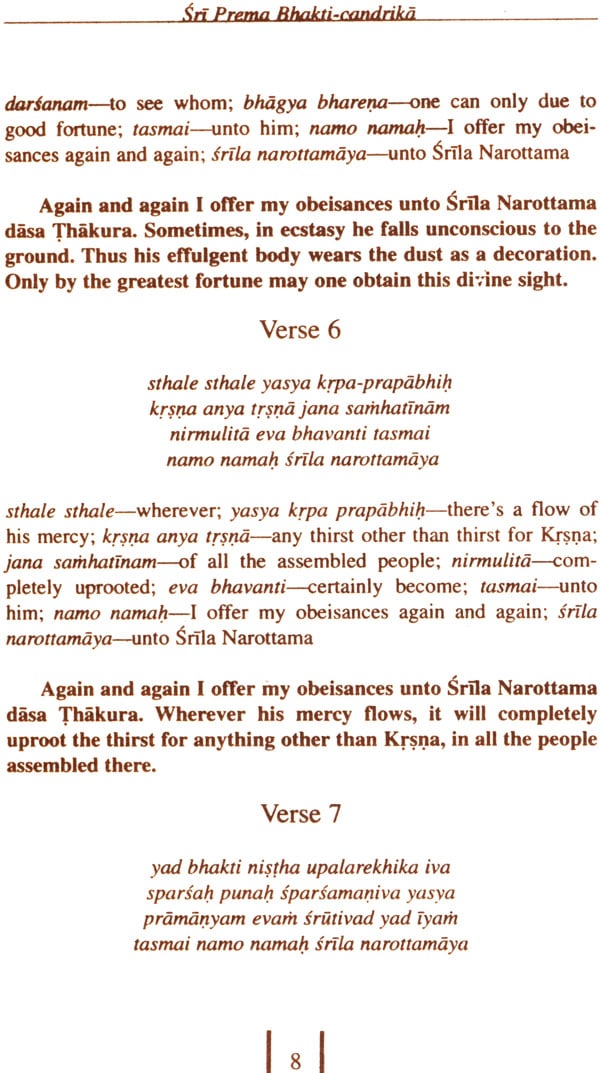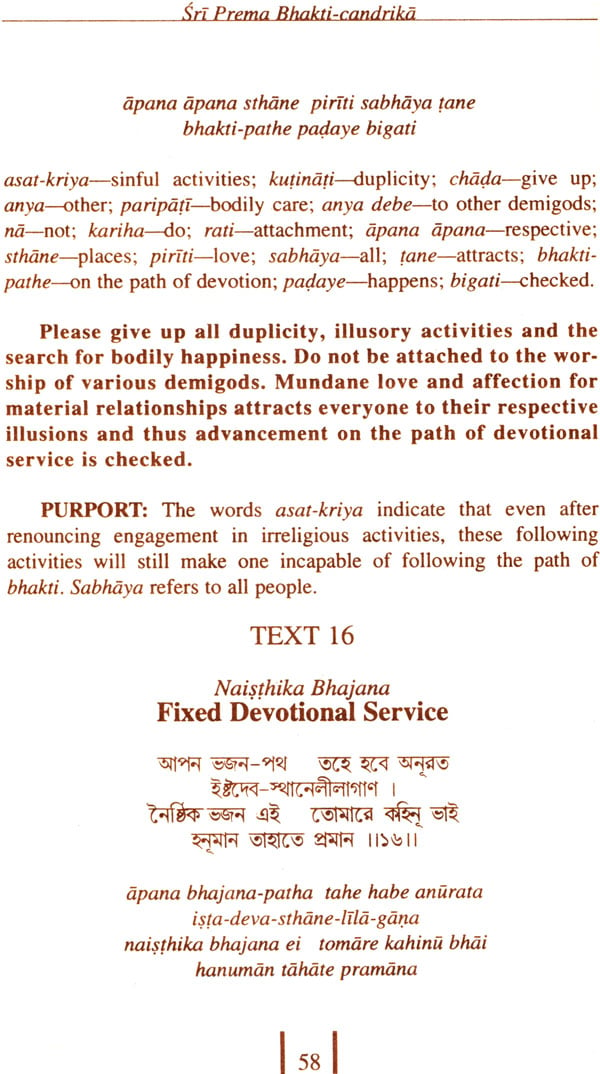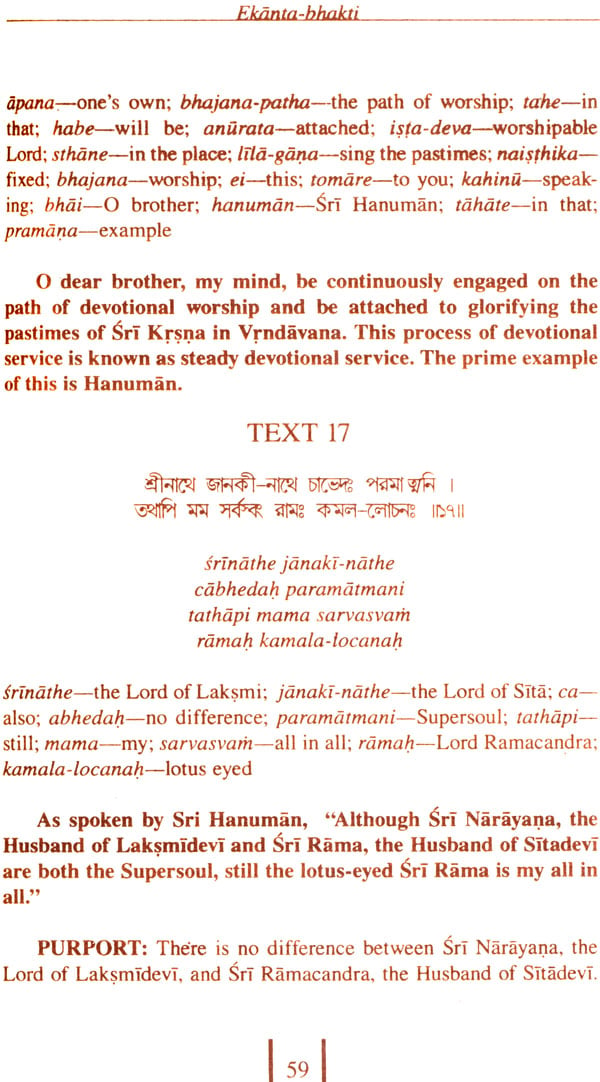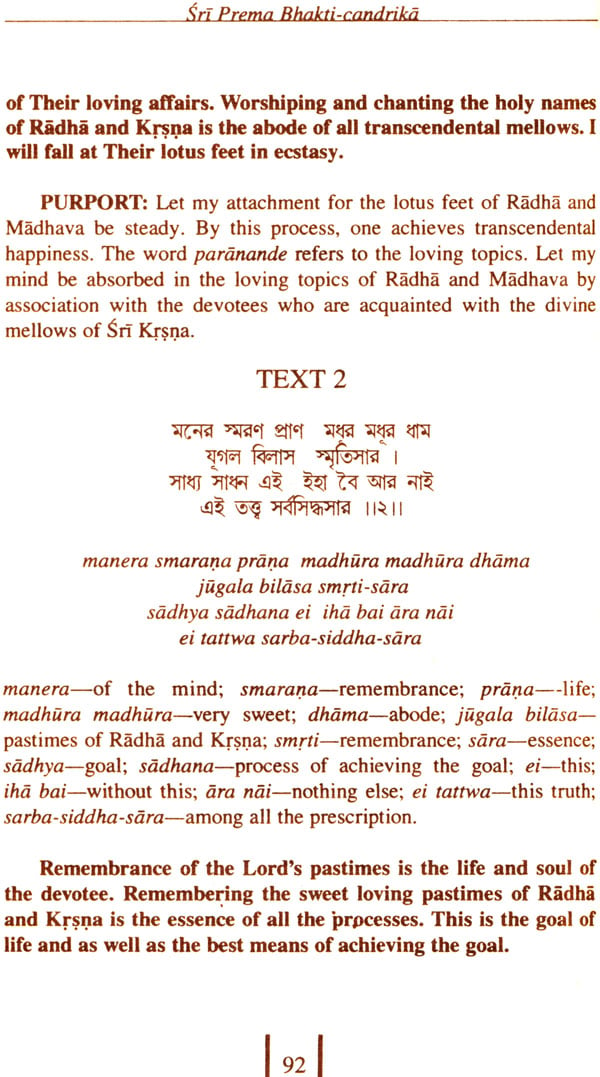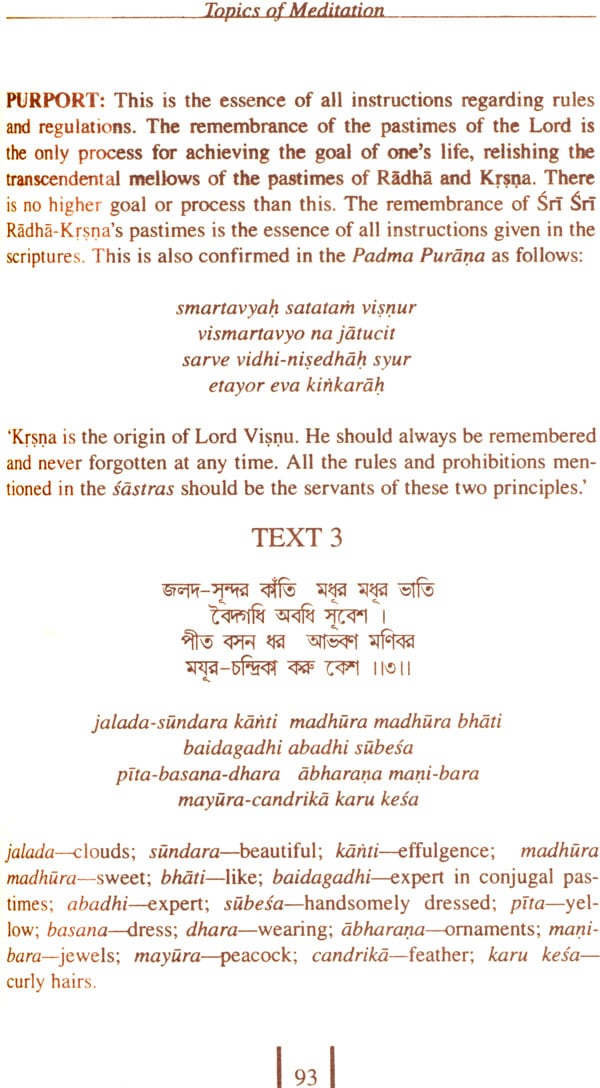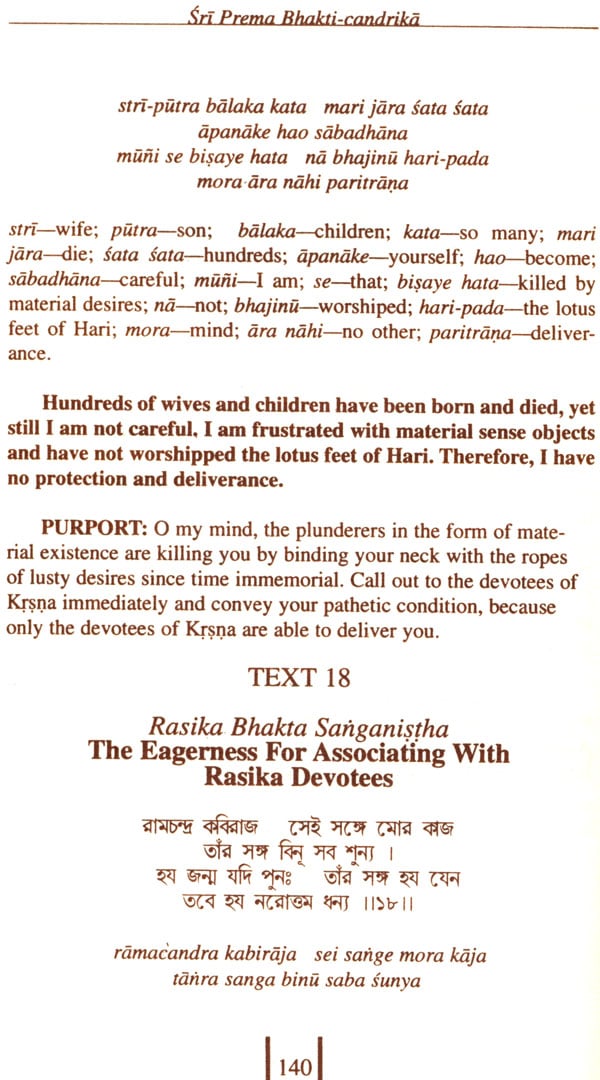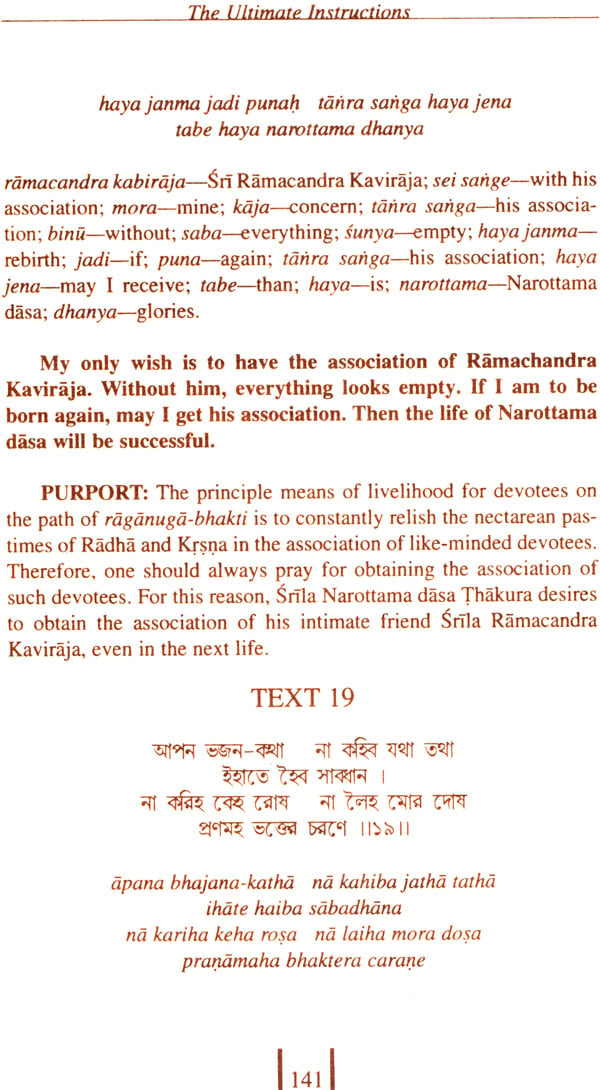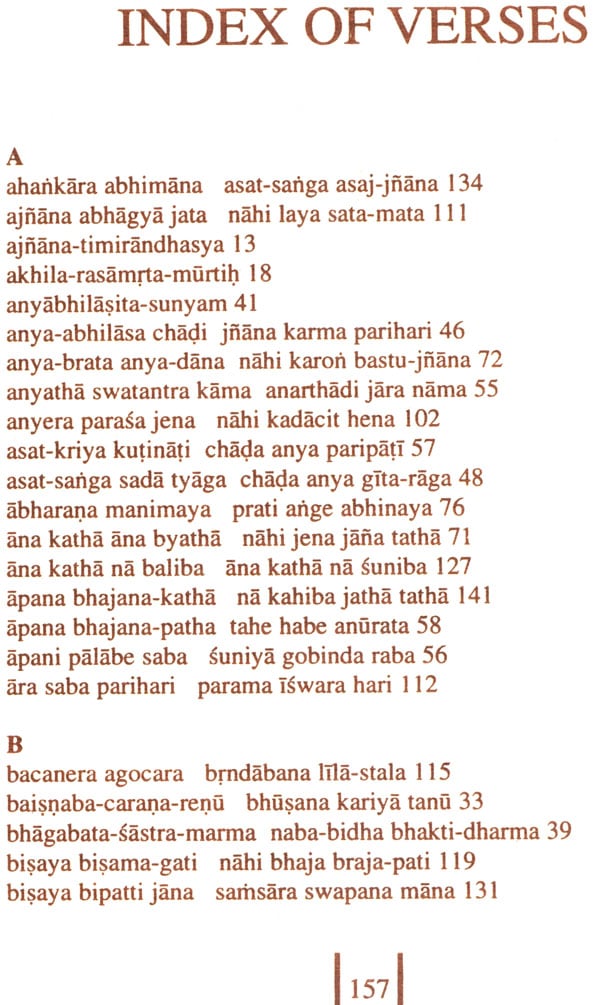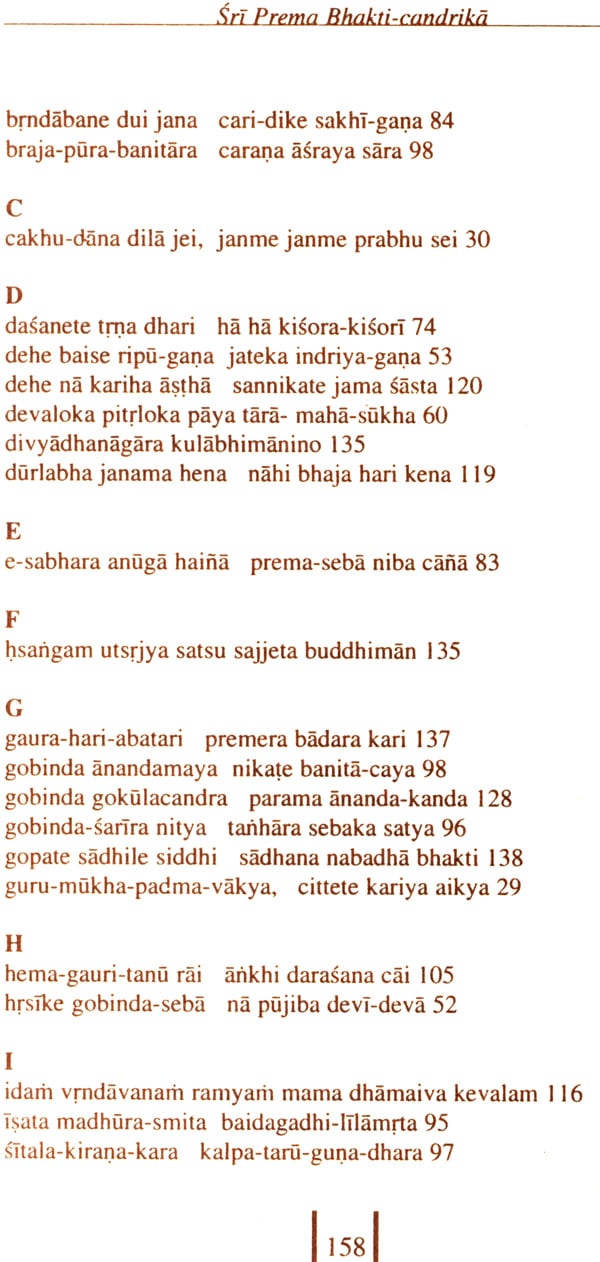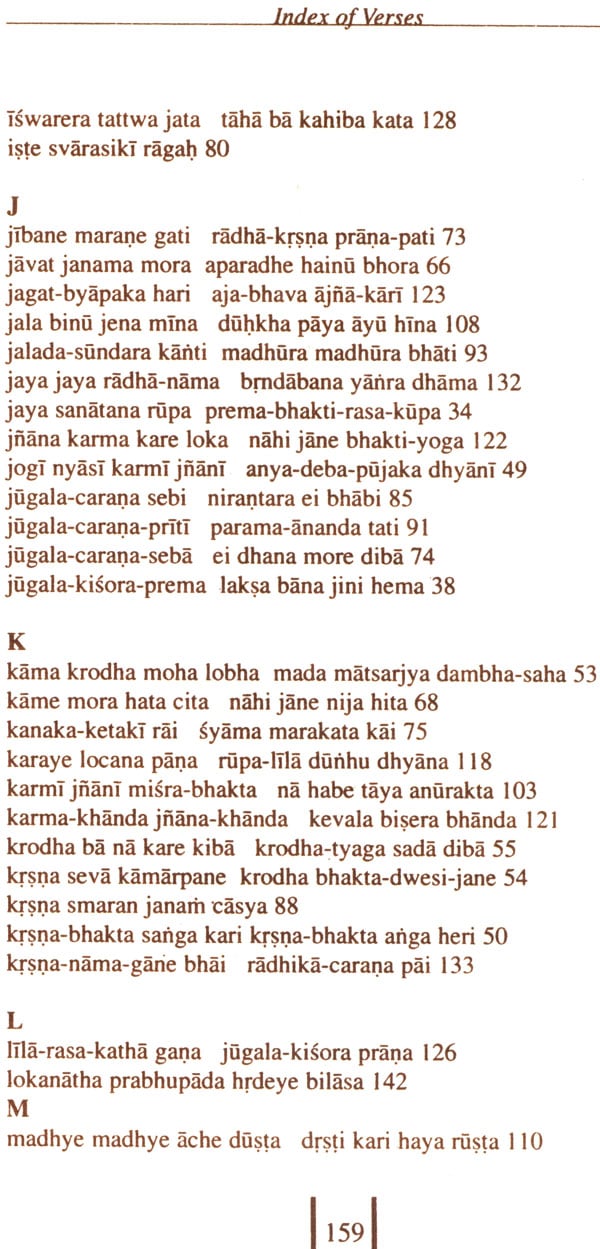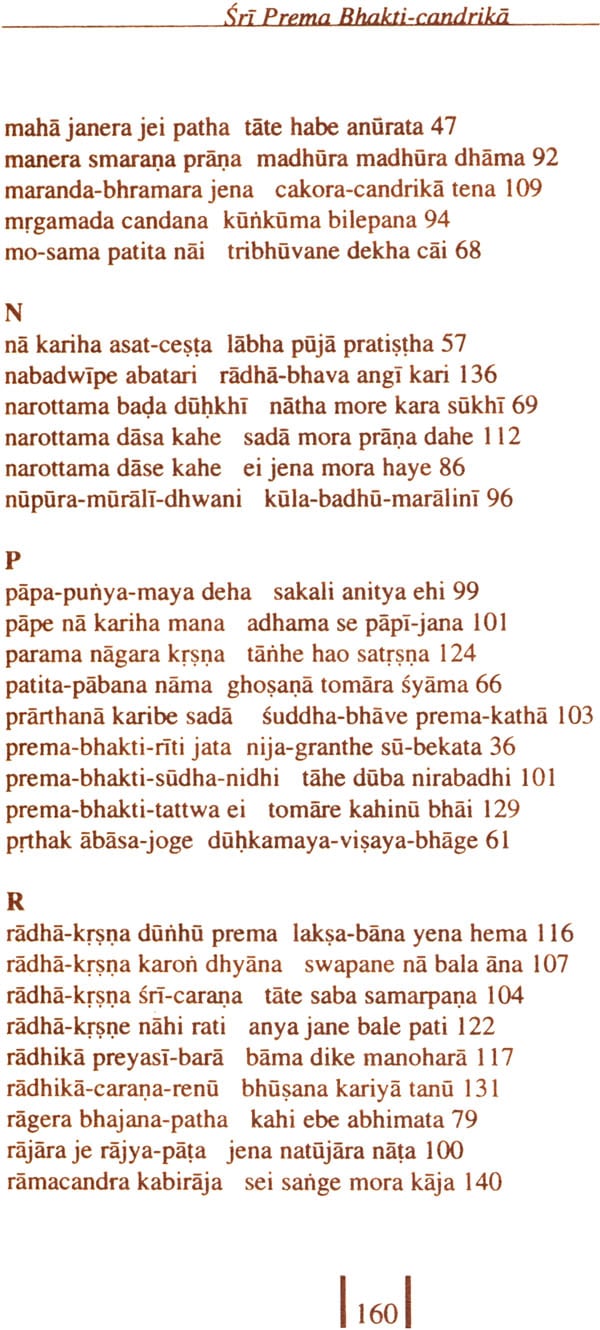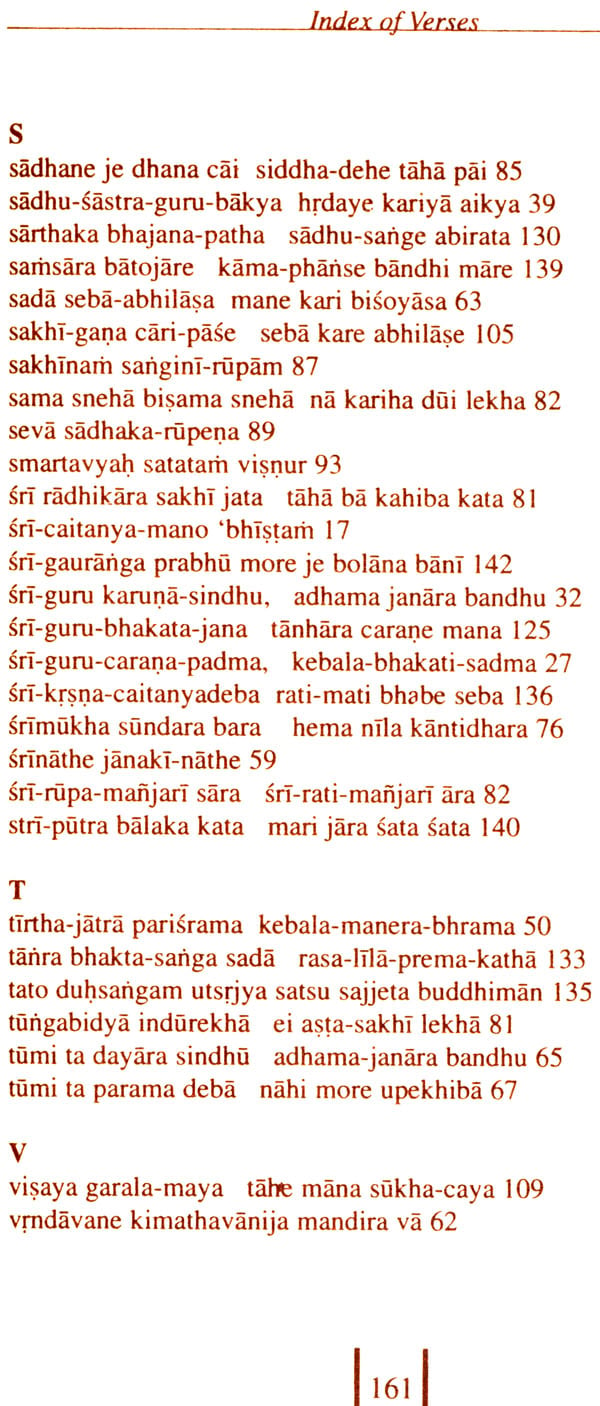
Sri Prema Bhakti-candrika (The Moonrays Of Loving Devotion)
Book Specification
| Item Code: | IDI649 |
| Author: | Srila Narottama Dasa Thakura |
| Publisher: | Touchstone Media |
| Language: | Bengali Text With Transliteration and Word-to-Word Meaning English Translation |
| Edition: | 2017 |
| ISBN: | 9788193481424 |
| Pages: | 161 |
| Cover: | Paperback |
| Other Details | 8.3"X 5.3 |
| Weight | 200 gm |
Book Description
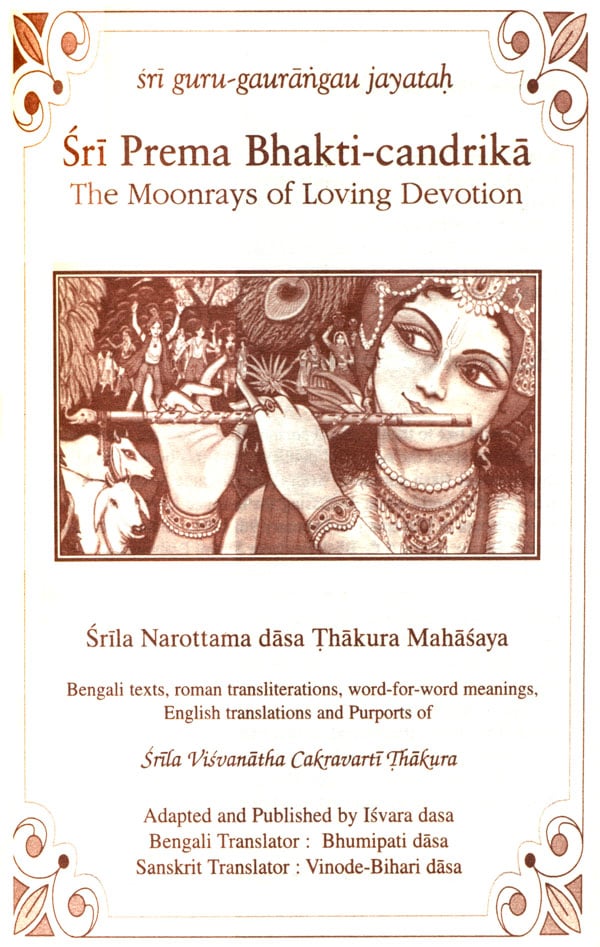
Introduction
Sri Prema Bhakti-candrika is perhaps the most important of all of Srila Narottama dasa Thakura's work during his manifest pastimes on earth a little over four hundred years ago. Srila Narottama dasa Thakura wrote many songs that were full of instructions. The most popular among his works, are Prarthana, and Sri Prema Bhakti-candrika.
Prema Bhakti-candrika is known as sri rupanuga-gita as it contains the essence of all the teachings of Lord Caitanya Mahaprabhu. Prema Bhakti-candrika literarily means, the rays of the moonlight of loving devotional service to Lord Krsna. These rays of the moonlight of Prema-bhakti are so soothing that they cool down the effects of the burning fire of material existence, and they enable the conditioned soul to drink the nectar of loving devotional service of Sri Sri Radha Krsna.
The personality and mission of Lord Caitanya Mahaprabhu was summarized by Srila Svarupa Damodara Gosvami in the following sloka:
samarpayitum unnatojjvala-rasam sva-bhakti-sriyam
harih purata-sundara dyuti-kadamba-sandipitah
sada hrdaya-kandare sphuratu vah saci-nandana
"May that Lord, who is known as the son of Srimati Sacidevi, be transcendentally situated in the innermost chambers of your heart. Resplendent with the radiance of molten gold, he has appeared in the age of Kali by His causeless mercy to bestow what no other incarnation has ever offered before, the most sublime and radiant spiritual knowledge of the mellow taste of His service.
This unnatojjvala-rasa, or the condensed elevated mellows of devotional service is the real hankering of the followers of Srila Rupa Gosvami, who are known as rupanugas. What makes the followers of Srila Rupa Gosvami so unique? Srimati Radharani has unlimited sakhis headed by Lalita devi and Visakha devi. These sakhis are in the same age group as Srimati Radharani. Thus they sometimes have direct dealings with Lord Krsna. The sakhis facilitate the pastimes of Radha and Krsna, and sometimes "Srimati Radharani arranges that Her friends have direct union with Krsna. However the direct maidservants of Srimati Radharani are the manjaris; manjari means "bud, young, or very tender". The manjaris are young and innocent girls. Their ages not more than that of a thirteen years old. They are the exclusive maidservants of Srimati Radharani. The unique position of the manjaris is that they are allowed to witness the intimate loving pastimes of Radha and Krsna in the inner chambers of the groves of Vrndavana, and render personal service there, to which the sakhis have no access. Thus they relish the unparallel bliss of bhakti-rasa. One of the principal manjaris is Sri Rupa Manjari, who incarnated as Srila Rupa Gosvami in gaura-lila. Srila Narottama dasa Thakura composed a very beautiful song in praise of the dust of the lotus feet of Sri Rupa Manjari. This song is in the prarthana as follows; sri Rupa manjari pada sei more sampada sei mora bhajana pujana. Rupanuga bhajana means following the footsteps of Srilla Rupa Gosvami, is to become a maidservant of Srimati Radharani. Srimati Radharani's love for Krsna is so intense that Krsna is maddened by it and so accepts the form of Lord Caitanya Mahaprabhu in order to understand and relish the love of Himself.
While relishing love o Krsna, Sri Caitanya Mahaprabhu revealed to the world the essence of Krsna-bhakti. He gave to the world what was never given before - love of Krsna, as practiced by the inhabitants of Vrndavana. Lord Caitanya Mahaprabhu to write volumes of devotional scriptures about the nature of this love of Krsna.
The Gosvamis carried out the instructions of Lord Caitanya Mahaprabhu by writing volumes of devotional scriptures such as: Sri Brhad-bhagavatamrta, Bhakti-rasamrta-sindhu, Ujjvalla-nilamani, Hari-bhakti-vilasa, Lalita-madhava, Vidagdha-madhava, Sat-san-darbhas, and others. Srila Krsnadasa Kaviraja Gosvami then took the essence from these writings, and presented it to the world in the form of Sri Caitanya-caritamrta.
Srila Narottama dasa Thakura Mahasaya was a disciple of Lokanatha Gosvami, a principal followers of Lord Caitanya. Lord Caitanya Mahaprabhu ordered Lokanatha Gosvami to go to Vrndavana and excavate lost places of Krsna's pastimes. He foretold the appearance of Narottama dasa to Lokanatha Gosvami, saying, he would have a disciple who will manifest a unique style of kirtana that will captivate all human beings.
Srila Narottama dasa Thakura studied along with Srinivasa Acarya and Syamananda Prabhu under Srila Jiva Gosvami. Thereafter, the famous trio were ordered to broadcast the writings of the Gosvamis in Bengal.
Being an empowered Acarya who teaches according to time, place and circumstance, Srila Narottama dasa Thakura composed Prema Bhakti-candrika in a simple style of Bengali language. Though the renditions of Sri Caitanya's teachings are simple, the purport is deep. The teachings of Lord Caitanya has thus been given in gist in the form of Sri Prema Bhakti-candrika. The Gosvami's books that were difficult to understand by the common masses were thus made easily understandable by the teachings of Srila Narottama dasa Thakura in his book - Sri Prema Bhakti-candrika.
The only book Srila Gaura Kisora dasa Babaji carried with him was Sri Prema Bhakti-candrika. Srila Bhaktissidhanta Sarasvati Thakura instructed all his disciples to daily read Sri Prema Bhakti-candrika. When asked about how to develop love of Godhead, Srila Gaura Kisora dasa Babaji instructed, "Go to the market place with five annas and purchase two books - Prarthana and Sri Prema Bhakti-candrika, by Srilla Narottama dasa Thakura. Read them daily, and you will develop love of Krsna.
This present English edition of Sri Prema Bhakti-candrika is perhaps the most complete so far. There are some other translations, but they have not been as comprehensive as this edition. In this edition, it is our fortune that we include a short commentary by Srila Visvanatha Cakravarti Thakura. There are a few commentaries on Sri Prema Bhakti-candrika, but the most authoritative are those composed by Srila Radha Mohan dasa, a grandson of Srila Srinivasa Acarya, and by Srila Visvanatha Cakravarti Thakura.
As a publisher of this book, Sri Prema Bhakti-candrika, I am simply a beggar of the mercy of Srila Narottama dasa Thakura. I hope that this presentation to the English speaking world will enhance and nourish the reader's progress in the development of love of Krsna.
| Introduction | 1 | |
| Srila Narottamastakam | 5 | |
| Mangalacarana | 13 | |
| | ||
| 1 | Sri Guru Mahima | 27 |
| Sri Vaisnava Mahima | 33 | |
| Glories of Srila Rupa and Sanatana Gosvamis | 34 | |
| Suddha Bhakti Tattva | 38 | |
| 2 | Ekanta Bhakti | 41 |
| Naisthika Bhajana | 58 | |
| 3 | Atma nivedana | 65 |
| 4 | Yugala Bhajana Nistha | 71 |
| 5 | Raganuga Bhakti Riti | 79 |
| The Truth About Sri Radhika and the Sakhis | 80 | |
| 6 | Topics of Meditation for Arousing Prema Bhakti | 9 |
| Braja Parakiya Tattva | 95 | |
| Sri Krsna Vigrahe Nityatva | 96 | |
| 7 | The Characteristics of an Unalloyed Devotee | 107 |
| 8 | Fixed Loving Devotional Service | 115 |
| 9 | The Ultimate Instructions | 127 |
| Sri Radhikasraya | 131 | |
| Sri Gaura Upasana Kathavyatha | 136 | |
| Raganukhyo Sadhana | 138 | |
| Manah Siksa | 139 | |
| Rasika Bhakta Sanganistha | 140 | |
| Appendix One | 147 | |
| Appendix Two: | ||
| Descriptions of the Colors and Dresses of the Sakhis | 149 | |
| Appendix Three: | ||
| Descriptions of the Color and Dresses of the Manjaris | 152 | |
| Guide to Bengali Alphabets and Pronunciations | 155 | |
| Index of Verses | 157 | |
| All purports are by | ||
| Srila Visvanatha Cakravarti Thakura, unless indicated otherwise. | ||
| The purports on Akhila-rasamrta-murti and anyabhilasita-sun-yam' verses from Srila Rupa Gosvami's Bhakti Rasamrta-sindhu, by Srila A. C. Bhaktivedanta Svami Prabhupada are taken from pre- 965 BTG editions. |
